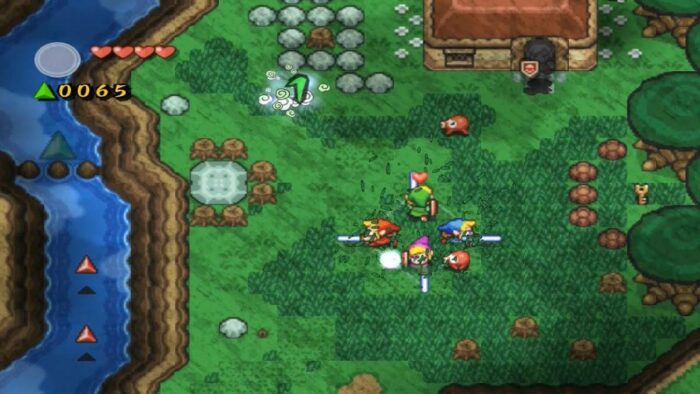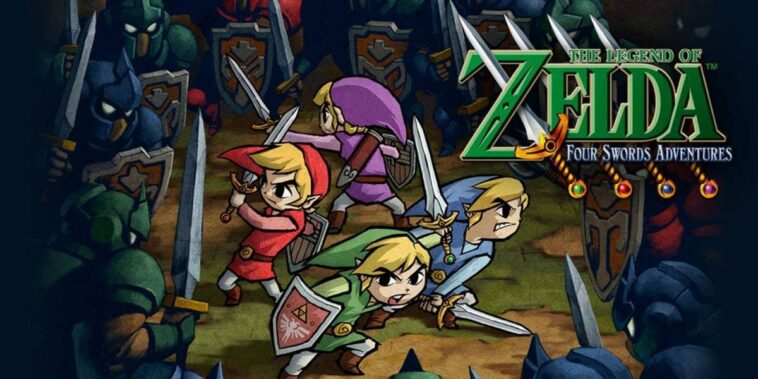At 25YL, we love gaming, and moreover, we love The Legend of Zelda series. That’s why we’re going to cover the entire Nintendo Franchise, including handheld games, every week. This week, we are taking a look at Four Swords Adventures.
To say that Four Swords Adventures for the excellent Nintendo GameCube is kind of a weird entry in the beloved Zelda series is an understatement. Gone were the wide open worlds of games past, instead replaced by individual levels. Link was split up into four versions of himself. There was an attempted focus on multiplayer, but it used the mad awkward GBA-GameCube link cable that was too expensive to justify the cost needed to actually play with friends. A lot of people feel that it’s a much weaker entry into the Zelda series. It is true that it’s a relatively minor release, but it’s still a good game in its own right and worth a look for the curious.
Let’s get this out of the way- I never utilized the multiplayer component of this game. None of my friends had the GBA-GameCube link cable, and the multiplayer was built around it. I’m not 100% sure what Nintendo was going for exactly. Whenever you entered an interior in the levels, the game would switch to a GBA screen and you were ostensibly supposed to look down at the GBA in your hand. However, playing single player allowed you to use the GameCube controller, and interior locations simply appeared on the screen in the foreground with lower resolution graphics. While the GBA-GameCube link cable was useful for a lot of the Pokemon games that popped up in that era, Four Swords Adventures simply feels like an attempt to make a game around a peripheral when it would have been totally fine without it.

And a fine game it is. There are 8 worlds in total, with 3 levels apiece. Generally speaking, the game followed a flow of one linear level, one that was more exploration based, capping off the world with a full-fledged, classic style dungeon. And you might think that being level based would rob the game of what makes Zelda so special in the first place, but you would be wrong. Not only is there a surprising level of creativity and variety to the levels, but each one is a densely packed mini sandbox with secrets to uncover.
By now, if you’ve read a few of my articles on this site, you know that I really appreciate weirdness in games. Because of this, not only is the strange Village of the Blue Maiden level my favorite in the game, but also one of my all-time favorite sequences in the series. A lot of the other levels in the game offer the nice mix of puzzle solving and action we love about the Zelda series. But Village of the Blue Maiden is a different beast entirely. It introduces the Dark World mechanic fairly early on. Essentially, you can carry a Moon Pearl to predetermined locations to open up a portal to the Dark World, where you can bypass obstacles and solve puzzles that directly impact the regular world.
In Village of the Blue Maiden, rather than having you navigate a traditional obstacle course, you instead need to explore the town and help get people who have gone missing back from the Dark World. There’s a strange, eerie song that plays that helps enhance the hazy and mysterious atmosphere the level goes for. It’s an incredibly unique and engaging sequence because it comes so out of nowhere and it stands out as a creepier, creative level.

The rest of the levels are no slouch either. In one world you travel through a haunted swamp before breaking in to Hyrule Castle in order to rescue one of the maidens taken by Vaati. In another you traverse Death Mountain to reach the temple at the top. The final world is probably the coolest, with it taking place in the clouds.
Even though the game is intended to be played with others, the single player mechanics are more than serviceable. You directly control Green Link and are followed by Red, Blue, and Purple. Flicking the C stick will activate different formations for the Link to do battle in such as a cross or a box. Then you can press the X button to switch between controlling each Link individually, helpful for when switches are far away. You can return everyone to the standard formation with a simple press of the Y button. It’s a surprisingly intuitive control scheme, but one that helps immensely in enjoying single player.
The game handles items in a weird way. Traditionally, you get an item in a Zelda game and that’s that. You have it and can use it whenever. Here though, you have to find item pedestals that hold classics such as the Fire Rod and Roc’s Feather. In single player, you can only have one at a time, which is admittedly a drag. I’d imagine that this is where having a team of people comes in handy, as in multiplayer, each player can have their own item. Using the items is fun, though, as they tend to be pretty powerful and can sometimes be upgraded to be even more potent depending on the level.

Perhaps the most contentious feature is that you only start each level with 3 hearts (more can be found in each one) and you need to find 2000 Force Gems in order to break the seal to the next level. On paper, I can see why some wouldn’t like this – after all, character progression is a huge part of the appeal of the series. For Four Swords Adventures, though, it works. Each level has more than enough Force Gems for you to reach the 2000 required, but they do offer extra incentive to explore each level thoroughly.
The bosses are pretty great as well. They make full use of the four Links. For instance, the Manhandla fight now requires you to hit the appropriately colored hand with the matching Link. In another, you have to strategically place your Links so they can hit a flying eyeball. Then there’s the ever classic Phantom Ganon fight, where you must volley a ball of energy back and forth, eventually delivering the final swing with the right colored Link. There aren’t a huge amount of boss encounters, but the ones that are there stand out.
As for aesthetics, they’re a nice mixture of Wind Waker’s cartoony character designs and the 2D artwork and world of A Link to the Past. The game certainly wasn’t pushing any boundaries for the GameCube, but there’s a nice mixture of 2D and 3D that still looks pretty solid to this day.
There’s not too much more to say about Four Swords Adventures. It was never destined to be anybody’s favorite Zelda title. There’s nothing particularly memorable about the “rescue six maidens from Vaati” storyline, and the fact that the game progresses level by level rather than the organic worlds of other titles likely turned a lot of people off. It didn’t help that it was billed as a multiplayer game, but you needed a rather pointlessly complicated peripheral in order to play it with friends. But all of this is hiding the simple fact that its level design is absolutely rock solid, and even if you can’t play with friends, it is completely enjoyable as a single player experience. Any fan who has turned their nose up at it should give it another shot. To me, THIS is the kind of game that would be perfect for the Switch. With online multiplayer and local co-op being a breeze now, I believe the game could find a new life and fan base on Nintendo’s awesome handheld console.

